Many of you who read my stuff know two things about me, (or are about to). I’m a huge fan of college women’s softball, and I’m a fan and consistent user of public transportation. I was in OKC for the Women’s College World Series, a tournament I’ve been wanting to attend for quite a few years. I also had an intentional plan to visit the Memorial to the bombing of the Oklahoma City Federal Building on a peaceful spring morning in April of 1995.
Here’s a plug; most cities have a public transportation website that’s user friendly. It’s not always the most convenient method, but if it is, it eliminates all the worry about how to get somewhere in your car, where to park when you get there, and how much parking will cost. Instead, it gets your legs moving and allows you to see and experience the city in a different way. And so I found myself on a bus ride that terminated at the Downtown Transit Station which is two short city blocks from the Memorial. I had planned to spend about one and a half to two hours at the Memorial. It turned out to be four and half. Most of that was just spent sitting in different places throughout the grounds in a state that was somewhere between lump in the throat and tears. It was for me a very emotional experience.
A lot of that time, and time since, I’ve spent trying to figure out how I define what hallowed ground is. It’s easy for me to list places that I consider hallowed ground, but not so easy to put words on a personal definition. Fact is I’m still trying to figure that out. The list of places in my head doesn’t necessarily have a lot of common denominators. And I’m pretty sure it isn’t solely about loss of life. One thing I have been able to identify for myself; hallowed grounds are places of immense serenity. The kind of serenity that keeps you there for four and half hours and makes it hard to leave. The serenity is caressed by how beautifully designed and cared for the grounds are.
This small sculptor garden sits on the corner of the block containing The Cathedral of St Joseph. The church was largely shielded from the blast by the Federal Building itself, but on this corner was an old historic chapel. It, and the Rectory, were damaged beyond saving.
It is across the street from one end of the Memorial Site. Behind Jesus is the monolithic entrance of one end of the grounds, and the building you see in the background, which now houses the museum, was then a records building.
Because this was a crime scene, the area was surrounded by chain link security fencing. A number of sections still stand to this day right where they were put up, and have remained as collection sites for notes, flowers, mementos, and personal remembrances. Even now, as I think about walking along this fence, I begin to well up.
The reflecting pool is where NW 5th Street was that ran past the front of the Federal Building. The Monoliths at each end mark the time 9:01, the last moment of innocence, and 9:03, the moment healing began. The tree below marks the spot where Timothy McVeigh parked his Ryder Rental truck, walked away, and detonated it at 9:02.
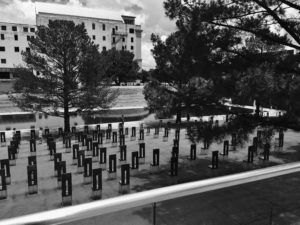 Each person that was lost that day has an empty chair. The chairs are in the area where the Federal Building once stood and symbolize the chairs that will forever remain empty at desks, dinner tables, and classrooms of the lives that will never be. 19 children died in a day care center that day and their chairs are smaller than the rest. The chairs are lit from underneath and I was left wishing I could have returned at night. I have no doubt the site has a different kind of power at night.
Each person that was lost that day has an empty chair. The chairs are in the area where the Federal Building once stood and symbolize the chairs that will forever remain empty at desks, dinner tables, and classrooms of the lives that will never be. 19 children died in a day care center that day and their chairs are smaller than the rest. The chairs are lit from underneath and I was left wishing I could have returned at night. I have no doubt the site has a different kind of power at night.
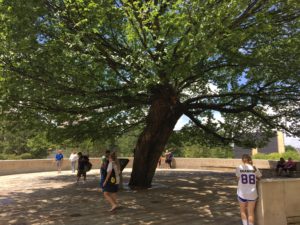 This tree stood in what was then a small parking lot across the street from the Federal Building. After the blast it was pretty much a bare trunk with two stump branches. It became the subject of a lot of discussion in the days and weeks following the devastation. Some thought it should simply be removed. But it became the symbol of healing and surviving. If you look back at the black and white photo above you can see it near the center. In the museum are photos of the tree at 9:03 and then the years of it’s slow return to thriving. It truly became an important symbol. I wouldn’t have thought I could be so emotional looking at pictures of a tree and then standing underneath it, bathed in it’s shade on a hot Oklahoma day.
This tree stood in what was then a small parking lot across the street from the Federal Building. After the blast it was pretty much a bare trunk with two stump branches. It became the subject of a lot of discussion in the days and weeks following the devastation. Some thought it should simply be removed. But it became the symbol of healing and surviving. If you look back at the black and white photo above you can see it near the center. In the museum are photos of the tree at 9:03 and then the years of it’s slow return to thriving. It truly became an important symbol. I wouldn’t have thought I could be so emotional looking at pictures of a tree and then standing underneath it, bathed in it’s shade on a hot Oklahoma day.
 This photo is from the terrace where the tree stands. In the distance is the steeple of The Cathedral of St. Joseph. And below is a message scribed on the side of the records building, now the museum, by the crews that were working in the rubble of the aftermath.
This photo is from the terrace where the tree stands. In the distance is the steeple of The Cathedral of St. Joseph. And below is a message scribed on the side of the records building, now the museum, by the crews that were working in the rubble of the aftermath.
My words in this post cannot adequately express how emotional visiting this site was for me. If you are ever in Oklahoma City, please go. It deserves all of the import we can bring to it. We can’t let it fade to nothing in our collective memory. Which brings me to the little story I’ll end this post with.
On the Friday morning after I returned from Oklahoma I had the occasion to sit next to a young man at our monthly breakfast for St. Paul’s Outreach. He had just graduated from the U and was heading to the University of Missouri, Kansas City, for a year of campus ministry. In our conversation that morning I was telling him about my trip to OKC and my visit to this memorial site. It was clear from the look on his face that he didn’t have a clue about what I was talking about. He deserves no criticism for this because he was born in 1993. He was two years old when this happened. So what do we do with that? We don’t teach what in my day we called Civics, or Government. We don’t teach Geography. I get the impression that we barely emphasize history at all, unless kids choose to major in it in college. How do we not lose these pieces of history that shape who we have become as a nation, as a culture? Our memorials that mark one horrific day and it’s aftermath, like 9-11 or Oklahoma City, or a horrific three days like Gettysburg, certainly do that. A visit to Washington, D.C. is a concentrated example of these efforts. I think everyone should go. But is there a greater point here about what we preserve? What we choose to preserve. How far have we wandered from the vision, and more importantly, the faith in God that shaped our founding fathers and mothers? Is the challenge to preserve not just about incidents? Is it also about resources? Is it also about ideas? About stories? As time marches, the last witnesses to things and events leave us. And the “new” witnesses to things learn about what’s important, how? Bringing it down to a personal level, should I be having conversations with my family and friends about Viet Nam, something I almost never do? Or is The Wall enough?
These are just a few of the things I’ve been thinking about since visiting this site. During the whole trip back my head started to write this post. That was now four weeks ago. Since being back I would look at the photos, write a little bit, delete a little bit, think a little bit, you get the picture. Then, there was added to this, a perfect storm of time consumption; getting ready to list my place, team preparation for an upcoming retreat weekend I’m working, and getting involved in two new volunteer activities. And of course all this mixed with the usual workouts at the Y, naps, bike rides, reading, hangin’ with the kids, hangin’ at the cigar shop, blah, blah, blah. It’s time to stop.
I am well and hope you all are too! 🙂
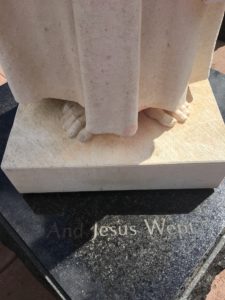
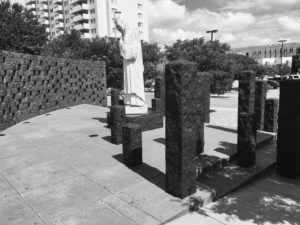
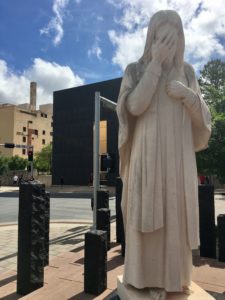
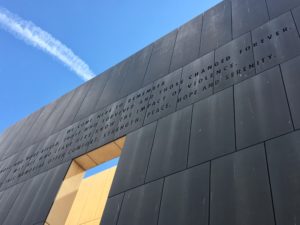
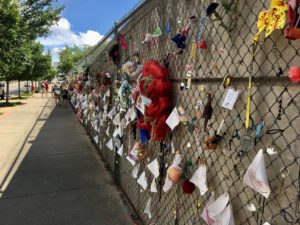
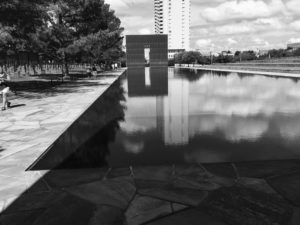


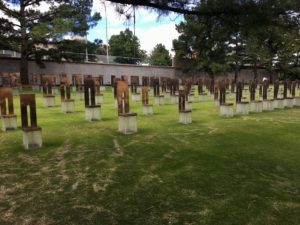
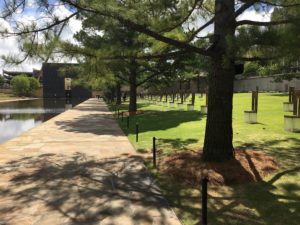
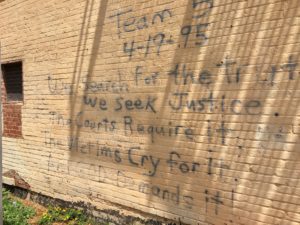
Thank you for sharing this. You have now added another site that I would love to see and experience. I miss your words and your wisdom. Love ya!